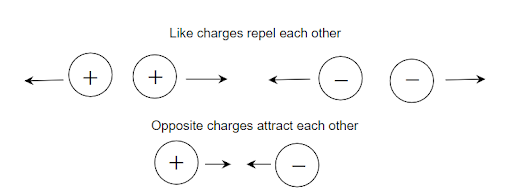
What are the basic electrical principles?
Answer
134.4k+ views
Hint: Electrical principles includes the concepts of charge, electric current, voltage,electric power, conductors and insulators.
Complete step by step solution:
Some of the electrical principles are as follows:
Charge: While some electrons are bound in an atom, they are all similarly attached to protons. The atom's electrons that are farthest from the nucleus can be extracted. Because there are fewer electrons in the atom when some electrons are taken out, there are more protons than electrons.
The electrically neutral body becomes positively charged after the elimination of electrons. The body can also get electrons from an outside source, which is the opposite of the first scenario. In this instance, the body's electron count rises and it acquires a negative charge. An electric charge is a difference between an excess or shortage of electrons in a body. In coulombs, the electric charge is expressed.

Image: Basic electrical principles
Conductors and insulators: Materials with weakly bonded valence or outside electrons are referred to as conductors. Aluminium, copper, gold, and silver are all effective conductors. Materials with securely bonded valence electrons are known as insulators. Insulators include things like glass, air, and stone.
Electric current: Electric current is defined as the number of charges per unit time passing through a boundary. In metals, because electrons are free to move around, the movement of electrons constitutes the electric current.
Voltage: As a measure of potential energy, the voltage between two locations or points is frequently arbitrary. It is frequently known as a "drop" voltage. When a voltage source is linked to a circuit, the voltage can induce a regular flow of charge carriers through the circuit, known as a current.
Electric power: In physics, electric power measures the rate of electrical energy transfer by an electric circuit per unit of time.
Note: The relationship between current, voltage, and resistance is expressed by Ohm's Law. This states that if the temperature stays stable, the current flowing in a circuit is exactly proportional to the voltage applied and inversely proportional to the circuit resistance.
Complete step by step solution:
Some of the electrical principles are as follows:
Charge: While some electrons are bound in an atom, they are all similarly attached to protons. The atom's electrons that are farthest from the nucleus can be extracted. Because there are fewer electrons in the atom when some electrons are taken out, there are more protons than electrons.
The electrically neutral body becomes positively charged after the elimination of electrons. The body can also get electrons from an outside source, which is the opposite of the first scenario. In this instance, the body's electron count rises and it acquires a negative charge. An electric charge is a difference between an excess or shortage of electrons in a body. In coulombs, the electric charge is expressed.

Image: Basic electrical principles
Conductors and insulators: Materials with weakly bonded valence or outside electrons are referred to as conductors. Aluminium, copper, gold, and silver are all effective conductors. Materials with securely bonded valence electrons are known as insulators. Insulators include things like glass, air, and stone.
Electric current: Electric current is defined as the number of charges per unit time passing through a boundary. In metals, because electrons are free to move around, the movement of electrons constitutes the electric current.
Voltage: As a measure of potential energy, the voltage between two locations or points is frequently arbitrary. It is frequently known as a "drop" voltage. When a voltage source is linked to a circuit, the voltage can induce a regular flow of charge carriers through the circuit, known as a current.
Electric power: In physics, electric power measures the rate of electrical energy transfer by an electric circuit per unit of time.
Note: The relationship between current, voltage, and resistance is expressed by Ohm's Law. This states that if the temperature stays stable, the current flowing in a circuit is exactly proportional to the voltage applied and inversely proportional to the circuit resistance.
Recently Updated Pages
JEE Main 2025 Session 2 Form Correction (Closed) – What Can Be Edited

What are examples of Chemical Properties class 10 chemistry JEE_Main

JEE Main 2025 Session 2 Schedule Released – Check Important Details Here!

JEE Main 2025 Session 2 Admit Card – Release Date & Direct Download Link

JEE Main 2025 Session 2 Registration (Closed) - Link, Last Date & Fees

JEE Mains Result 2025 NTA NIC – Check Your Score Now!

Trending doubts
JEE Main 2025 Session 2: Application Form (Out), Exam Dates (Released), Eligibility, & More

JEE Main 2025: Conversion of Galvanometer Into Ammeter And Voltmeter in Physics

JEE Main 2025: Derivation of Equation of Trajectory in Physics

Wheatstone Bridge for JEE Main Physics 2025

Degree of Dissociation and Its Formula With Solved Example for JEE

Electric field due to uniformly charged sphere class 12 physics JEE_Main

Other Pages
JEE Advanced Marks vs Ranks 2025: Understanding Category-wise Qualifying Marks and Previous Year Cut-offs

Diffraction of Light - Young’s Single Slit Experiment

Dual Nature of Radiation and Matter Class 12 Notes: CBSE Physics Chapter 11

Electric Field Due to Uniformly Charged Ring for JEE Main 2025 - Formula and Derivation

Elastic Collisions in One Dimension - JEE Important Topic

Formula for number of images formed by two plane mirrors class 12 physics JEE_Main




